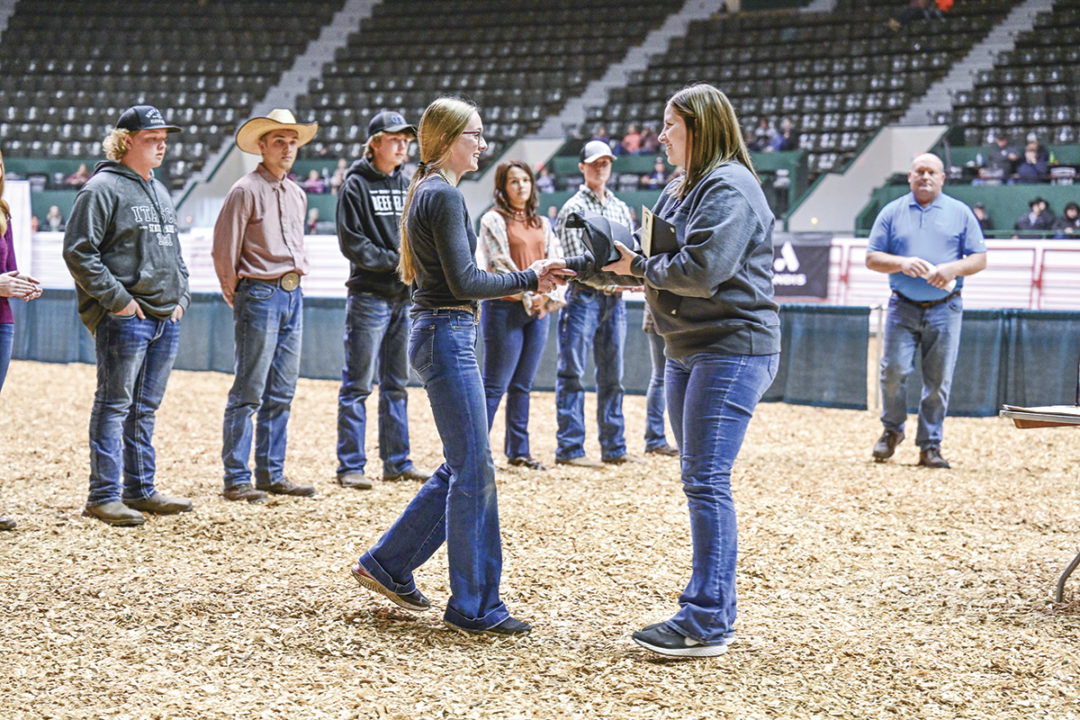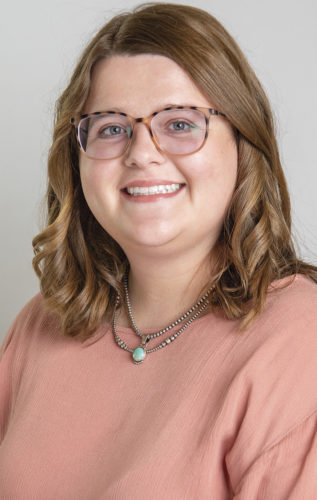One hundred and sixty heifers, 20 years, a one-of-a-kind program: That’s the Minnesota Youth Beef Experience Program (MYBEP). MYBEP connects young cattle enthusiasts with cattle producers and facilitates a mentor relationship between the two. MYBEP participants receive a heifer calf to raise, show and start their own herd with.
Since 2004, around 10 youths in the northern Midwest receive a donated heifer each year from local producers. Each recipient becomes responsible for raising, breeding and maintaining records for the animal, says Blaire Huneke, Minnesota State Fair agriculture communications supervisor and MYBEP coordinator. The breeders who donated heifers will serve as mentors to the MYBEP youth and help guide them through their first year as cattle owners.
The program
“The program essentially is here to help youth get their start in the cattle industry,” Huneke says. “The whole idea is that for youth who are interested in having a career in the industry – whether that's being a producer, a vet, working in sales or however they want to be involved in the industry – if they believe a heifer can help them reach their goals, we want to help them do that.”
Any youth ages 12 to 16 who are involved in 4-H, FFA or a breed association in Minnesota, Iowa, North Dakota, South Dakota or Wisconsin and are interested in the beef cattle and agriculture industry can apply for the MYBEP program, Huneke says
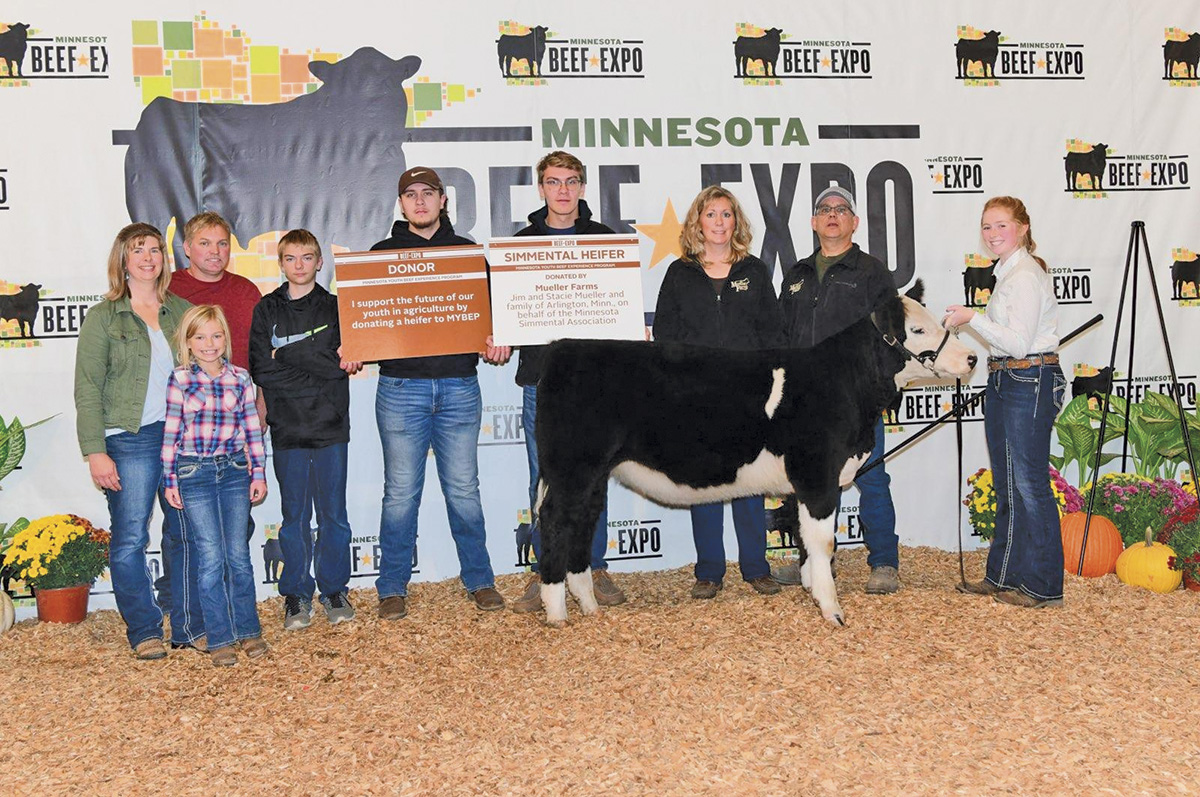
Lydia Rose (far right) received her MYBEP heifer in October 2022. Rose received a Simmental heifer, Rosie. She is pictured with her family and her donors and mentors, the Mueller family. Photo provided by Lydia Rose.
Youth fill out a hefty application, including a letter of intent, two letters of recommendation and the selection of preferred breeds, for a panel of judges to score, Huneke says. The highest-scoring applicant for each breed receives the heifer. While there are around 10 heifers donated each year, an average of 100 youth apply, Huneke adds.
In addition to the donated heifers, there is one heifer given out at the MYBEP Ideas and Insights Symposium each year on the Thursday night of the Minnesota Beef Expo, Huneke says. This “symposium heifer” is given to the applicant with the next highest score who is present at the program, she adds.
“The symposium heifer is given out at the expo each year to the person with the next highest score on their application,” says Brenden Bryce, 2022 MYBEP Symposium heifer recipient. “The Cattlemen’s [Minnesota State Cattlemen’s Association] gives you a certain dollar amount to purchase a heifer off the sale [Minnesota Beef Expo Supreme Row Sale]. You get to look through the catalog, watch the show and choose which heifer you would like.”
All heifer recipients are paired with a mentor. Many times, the donor also serves as a mentor. The recipient-mentor relationship is developed throughout the year as recipients have questions and mentors provide advice and guidance on raising and showing the heifers.
“This program is a unique opportunity for youth to interact with their mentor on a regular basis and include them on important decisions with the calf,” says Keely Neil, 2022 MYBEP Hereford heifer donor and mentor. “Just like many other things in life, the more time and effort you put into your project, the more you will get out of it. For many, this will be the start of their own herdhey are learning responsibility, sacrifice and a work ethic that is not taught in any textbook.”
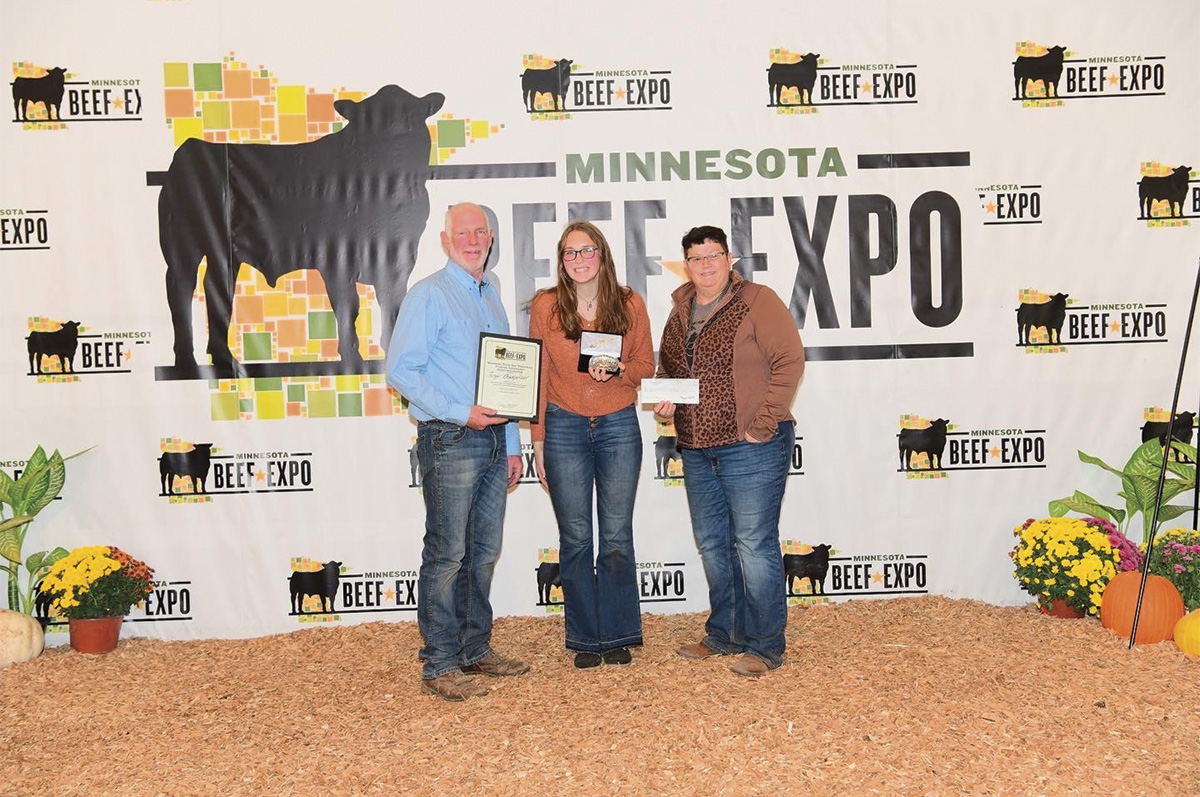
Liza Chamberlain (center) is pictured with her mentors and donors, Tom and Joan Waldron. Chamberlain received the 2021 MYBEP Shorthorn heifer and the 2022 Achievement Award. The Achievement Award consists of scores from quarterly reports, a scrapbook, a showmanship contest and an interview. The winner receives a scholarship and belt buckle. Photo provided by Liza Chamberlain.
The experience
Recipients are required to submit progress reports once a quarter throughout the year.
“Receiving a MYBEP heifer is a really big honor,” says Alison George, 2022 MYBEP Hereford heifer recipient and 2023 Achievement Award winner. “Not only does it provide opportunities for me to grow my herd, meet people in the industry and get better at showing cattle, but it encourages me to learn more about breeding, nutrition, keeping records and taught me how to be more responsible and better manage my time. I had some fun with my reports and developed a newsletter for my experience. Working on the reports also helped me with my writing skills and I learned how to use a design program too.”
At the end of the year, they're also required to submit an overall report, as well as make a scrapbook with photos of their experience, Huneke says. The scrapbooks are displayed at the Minnesota Beef Expo for everyone to see as a way to showcase the program and the recipients’ experiences.
“We see this as a way to help start to teach them the value of record keeping, as they will have to do it as part of the industry and raising their own herds,” Huneke says.
Additionally, they are also required to do a community service project throughout the year.
For Liza Chamberlain, 2021 MYBEP Shorthorn heifer recipient and 2022 Achievement Award recipient, one of her favorite memories from her time in the MYBEP program is her community service project, where she presented on beef cattle at the Minnesota State Fair Moo Booth. The Moo Booth offers activities and presentations on beef and dairy cattle during the Minnesota State Fair and is open to all fair attendees. She was able to include her MYBEP heifer in the presentation, allowing the public to see and experience cattle firsthand.
“We also require them to participate in at least one other show throughout the year,” Huneke says.
George notes going to shows with her MYBEP heifer was her favorite part of the year.
“I was able to attend many shows this last year with my heifer,” George says. “My favorite was Hereford Junior Nationals. Not only did I show but I did the livestock judging contest and photography contest. I also won a headstand contest and made new friends who love showing Herefords like me!”
The last requirement is for the recipients to come back to the expo the next year. One of the main things they will do is compete for the Achievement Award. The Achievement Award is selected based on scores from the quarterly and final reports, their scrapbook, a MYBEP-specific showmanship contest and an interview, Huneke says.
All these things are scored by judges and compiled together, Huneke says. The MYBEP recipient with the highest score is the Achievement Award winner. The winner receives a scholarship and belt buckle award, Huneke adds.
“All the MYBEP recipients from the year before come back to the Minnesota Beef Expo to compete for the Achievement Award,” George says. “This year [2023] I did that, and my hard work paid off because I won! It was a really cool experience because I got to show the judges all the work my heifer and I did and share all that I’ve learned during the year.”
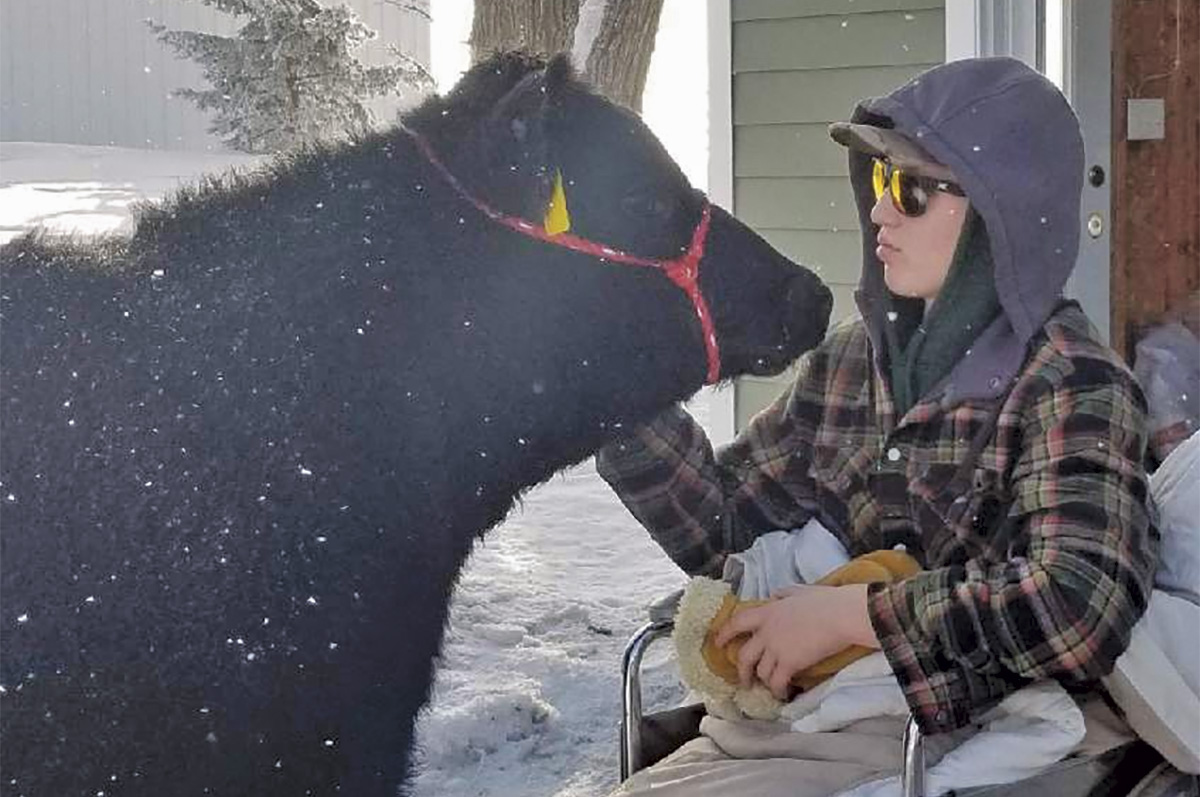
Brenden Bryce gives a chin scratch to his MYBEP heifer, Legacy. Bryce received the symposium heifer, donated by the Minnesota State Cattlemen’s Association, and was mentored by Mark Pesek. Bryce is pictured here in a wheelchair after an accident. His family helped him care for his heifer while he recovered, bringing her to visit him as he healed. Photo provided by Brenden Bryce.
The impact
For donors, there is no monetary incentive. Donors give youth a heifer out of the goodness of their hearts.
“And that's kind of the beauty of it, right?” Huneke says. “We hear from the donors that they really want to do this as a way to give back to the industry that's given them so much. They want to be there for a youth recipient who is looking to break through, just like somebody was once there for them.”
Tom Waldron recounts the positive experiences they’ve had serving as mentors and donating heifers for this program. Tom and his wife, Joan, donated a heifer in 2008 and 2021. They served as mentors both years, as well as another year when their heifer was purchased off the sale for the symposium heifer recipient.
They believe in the program and have firsthand experience watching recipients learn, grow and stay involved in the industry beyond their one year in the program. Each of their recipients and their families have stayed connected, meeting up at shows, stalling together and helping with show day activities.
“To me, receiving a MYBEP heifer meant people believed I can make it in the beef industry,” says Aubree Paplow, 2022 MYBEP Charolais heifer recipient. “Especially with being a female in a very male-dominated industry, it feels like people believed that I would be able to make it and wanted to help me get my own herd started.”
Both the Waldrons and Neils note how they’ve watched the MYBEP program grow and flourish from the beginning.
“Once our kids aged out of the junior program, we thought it was time our family stepped up and donated a heifer and served as mentors,” Neil says.
She adds that seeing the success in the show ring and the bond formed with the heifer was great, but it was the lifelong connections and friendships gained that were the best things about being a part of the program.
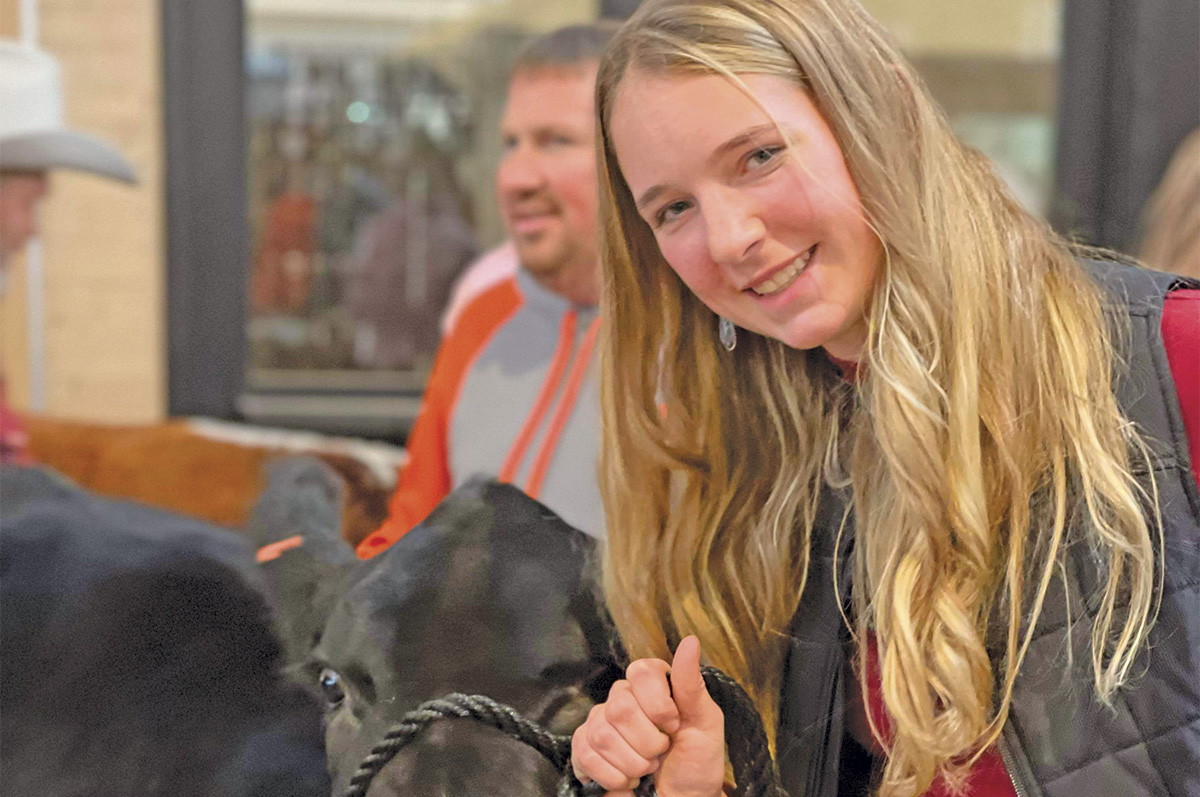
Macy Hunger stands with her Simmental heifer, Lily. Hunger received her MYBEP heifer at the 2023 Minnesota Beef Expo. The heifer was donated by Ryan Hecksel, who will mentor her. Photo provided by Macy Hunger.
The future
After completing their MYBEP year and competing at the Minnesota Beef Expo for the achievement award, the recipients get to keep their heifer to start growing their own beef cattle herd.
“In the future, I want to grow my herd of Simmental and Angus-cross cattle,” says Lydia Rose, 2022 MYBEP Simmental heifer recipient. “I want to keep a focus on improving genetic traits for market and breeding cattle. I would also like to keep an emphasis on show phenotype. I plan on growing my herd of cattle into my adult life as I plan to stay in the cattle and ag industry.”
Like Rose, George has similar plans with her heifer. Her goal is to have a purebred Hereford herd of cattle, focusing on show cattle. She plans on attending vet school for large animals and knows the experiences she has gained because of this program will help her well into the future.
“I wanted to apply for this program because I am super excited to grow my own herd,” says Macy Hunger, 2023 MYBEP Simmental heifer recipient. With Ryan's [Ryan Hecksel, her mentor] very generous donation, I will now have my own heifer to show and breed. I'm thrilled about receiving the animal but even more thrilled about all the new connections I will get to form with more members of the cattle community and teaching more people about not only beef but agriculture in general.”
This one-of-a-kind program has provided a way for the younger generation to get involved in an industry that means so much to many of us.
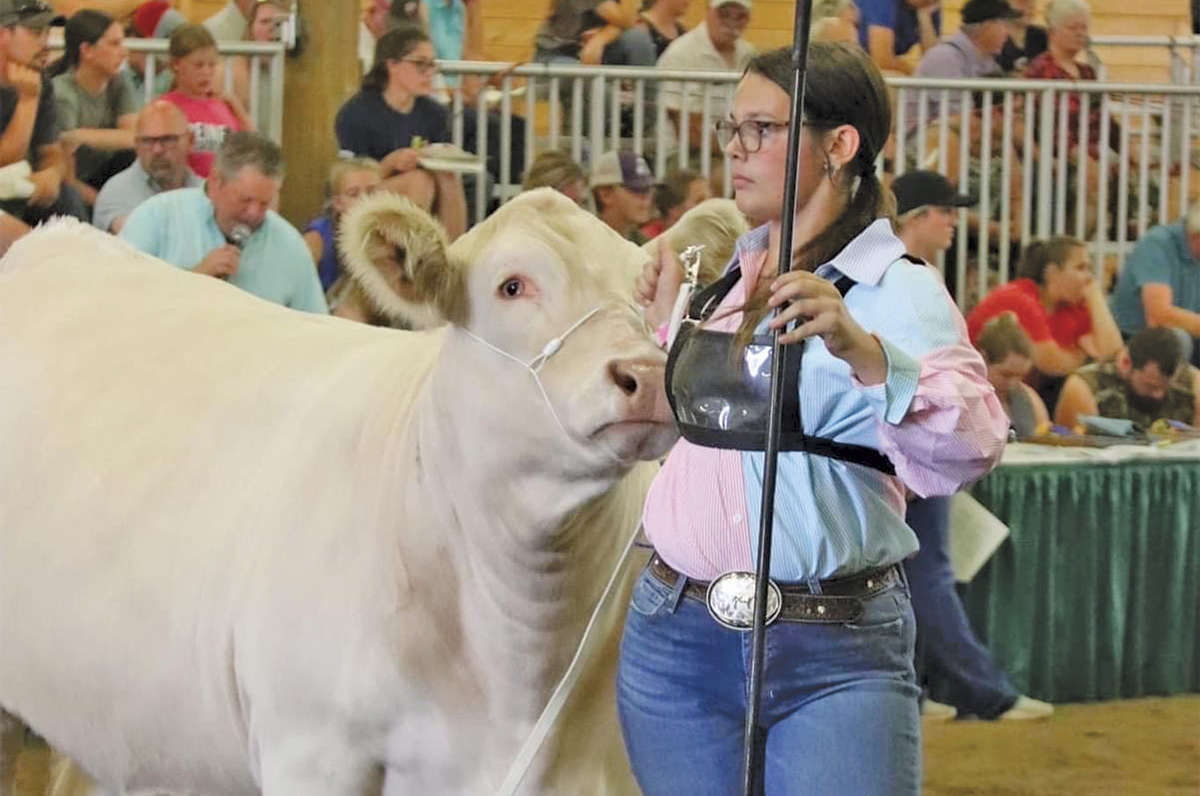
Aubree Paplow shows her MYBEP heifer. Paplow received the Charolais heifer, donated by the Minnesota/Wisconsin Charolais Association, which she named Phe. She was mentored by Chad Zehnder and Katie Nelson. Photo provided by Aubree Paplow.
“This past year has been unforgettable,” George says. “My favorite memory I made with Potato [her MYBEP heifer] was winning Grand Champion heifer at my county fair, which is something I’ve been trying to do since I started showing cattle eight years ago and was made possible because of the MYBEP program and the Neils [her donors/mentors].”
Something agreed upon by all, recipients, mentors and donors alike, is that the MYBEP program is providing a way for youth to get involved in the cattle industry in a positive way from a young age. The opportunities this program provides go beyond a heifer. It’s the hands-on experiences and lasting relationships that make this program so special.
